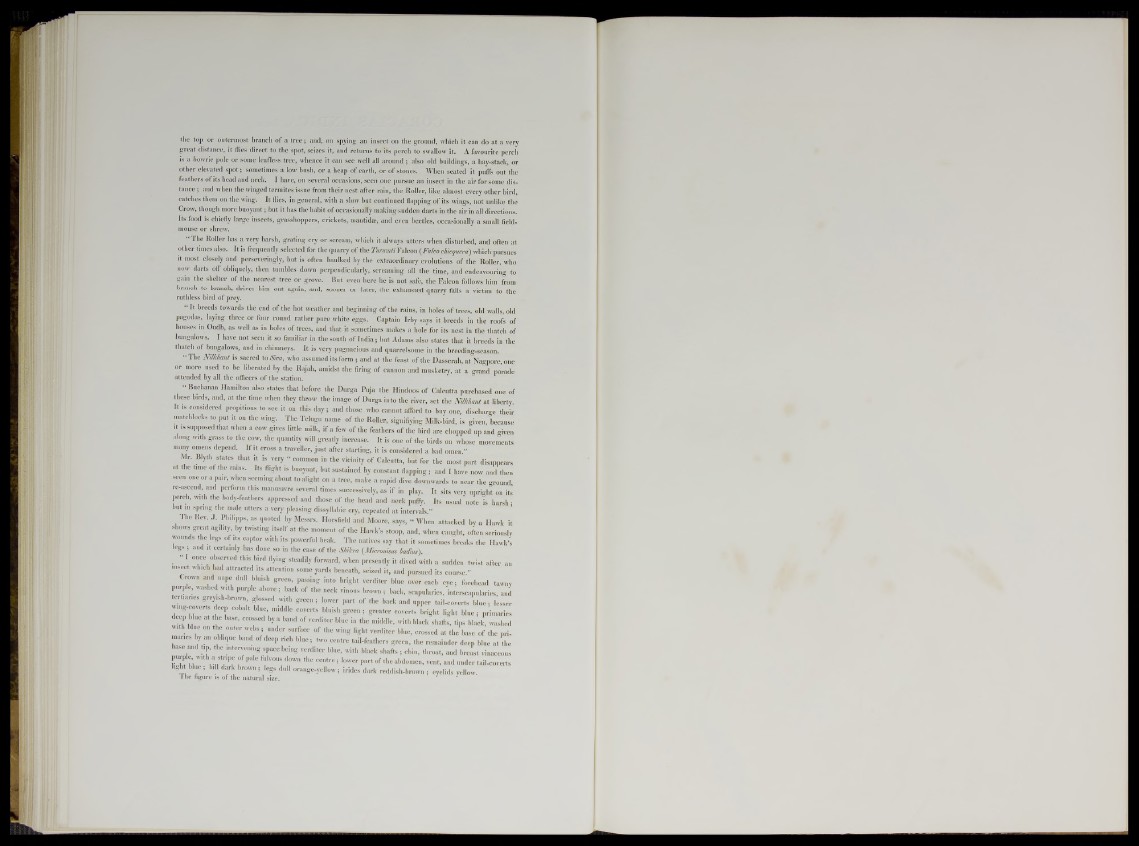
the top or outermost branch of a tree; and, on spying an insect on the ground, which it can do at a very
great distance, it flies direct to the spot, seizes it, and returns to its perch to swallow it. A favourite perch
is a bowrie pole or some leafless tree, whence it can see well all around; also old buildings, a hay-stack, or
other elevated spot; sometimes a low bush, or a heap of earth, or of stones. When seated it puffs out the
feathers of its head and neck. I have, on several occasions, seen one pursue an insect in the air for some distance
; and when the winged termites issue from their nest after rain, the Roller, like almost every other bird,
catches them on the wing. It flies, in general, with a slow but continued flapping of its wings, not unlike the
Crow, though more buoyant; but it has the habit of occasionally making sudden darts in the air in all directions.
Its food is chiefly large insects, grasshoppers, crickets, nmntidae, and even beetles, occasionally a small field-
mouse or shrew.
“ The Roller has a very harsh, grating cry or scream, which it always utters when disturbed, and often at
other times also. It is frequently selected for the quarry of the Turumti Falcon (Falco chicqueraj which pursues
it most closely and perseveringly, but is often baulked by the extraordinary evolutions of the Roller, who
now darts off obliquely, then tumbles down perpendicularly, screaming all the time, and endeavouring to
gain the shelter of the nearest tree or grove. But even here he is not safe, the Falcon follows him from
branch to branch, drives him out again, and, sooner or later, the exhausted quarry falls a victim to the
ruthless bird of prey.
“ It breeds towards the end of the hot weather and beginning of the rains, in holes of trees, old walls, old
pagodas, laying three or four round rather pure white eggs. Captain Irby says it breeds in the roofs of
houses in Oudh, as well as in holes of trees, and that it sometimes makes a hole for its nest in the thatch of
bungalows. I have not seen it so familiar in the south of India; hut Adams also states that it breeds in the
thatch of bungalows, and in chimneys. It is very pugnacious and quarrelsome in the breeding-season.
“ The Nilkhant is sacred to Ska, who assumed its form ; and at the feast of the Dasserah, at Nagpore, one
or more used to be liberated by the Rajah, amidst the firing of cannon and musketry, at a grand parade
attended by all the officers of the station.
“ Buchanan Hamilton also states that before the Durga Puja the Hindoos of Calcutta purchased one of
these birds, and, at the time when they throw the image of Durga into the river, set the Nilkhant at liberty
It is considered propitious to see it on this day; and those who cannot afford to buy one, discharge their
matchlocks to put it on the wing. The Telugu name of the Roller, signifiying Milk-bird, is given, because
it is supposed that when a cow gives little milk, if a few of the feathers of the bird are chopped up and given
along with grass to the cow, the quantity will greatly increase. It is one of the birds on whose movements
many omens depend. If it cross a traveller, just after starting, it is considered a bad omen.”
Mr. Blyth states that it is very “ common in the vicinity of Calcutta, but for the most part disappears
at the time of the rams. Its flight is buoyant, hut sustained by constant flapping; and I have now and then
seen one or a pair, when seeming about to alight on a tree, make a rapid dive downwards to near the ground,
re-ascend, and perform this manoeuvre several times successively, as if in play. It sits very upright on its
perch, with the bod,-feathers oppressed and those of the head and neck puffy. Its usual note is harsh:
but in spring the male utters a very pleasing dissyllabic cry, repeated at intervals.”
The Rev. J. Philipps, as quoted by Messrs. Horsfield and Moore, says, “ When attacked by a Hawk it
shows great agility, by twisting itself at the moment of the Hawk’s stoop, and, when caught, often seriously
wounds the legs of its captor with its powerful beak. The natives say that it sometimes breaks the Hawk's
legs ; and it certainly has done so in the case of the Shikra (.Micronisus badiusj.
“ I once observed this bird flying steadily forward, when presently it dived with a sudden twist after a„
insect which had attracted its attention some yards beneath, seized it, and pursued its course.”
Crown and nape: dull bluish green, passing into bright verditer blue over each eye; forehead tawny
purple, washed with purple above; back of the neck vinous brown; back, scapularies, interscapularies, and
tertiaries greyish-brovm, glossed with green ; lower part of the back and upper tail-coverts blue; lesser
wing-coverts deep cobalt blue, middle coverts bluish green; greater coverts bright light blue; primaries
deep blue at the base, crossed by a band of verditer blue in the middle, with black shafts, tips black, washed
with blue on the outer webs ; under surface of the wing light verditer blue, crossed at the base of the primaries
by an oblique band of deep rich blue; two centre tail-feathers green, the remainder deep blue at die
base and tip, the intervening space being verditer blue, with black shafts ; chin, throat, and breast vinaceous
purple with a stripe of pale fulvous down the centre; lower part of the abdomen, vent, and under tail-coverts
ght blue ; bill dark brown ; legs dull orange-yellow; irides dark reddish-brown ; eyelids yellow.
1 he figure is of the natural size.